Spelling, like math, is a subject that requires several foundational skills learned in sequential order, as shown in the diagram, beginning at the bottom and building up, one skill upon another. No one is born knowing how to spell correctly, but the individual steps to spelling proficiency can be somewhat tricky to identify by those who have already been reading for many years.
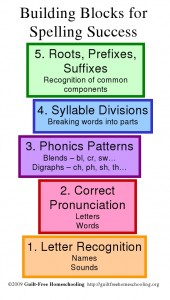 Skill #1 is the first building block: learning to recognize letters both by their names and by the sounds they represent. Since vowels can represent multiple sounds, depending on their combination with other letters, it is simplest to use their names and the short vowel sounds during the recognition phase. I preferred to teach my children upper case letters first, since that provides fewer opportunities for reversals (such as confusing b and d). Once the child knows the upper case alphabet well, the lower case letters can be introduced as the “little brothers” of the first set. Pairing the big brothers and little brothers together also helps avoid reversals, even when they don’t look that much alike—because kids easily understand the concept of siblings who belong together but aren’t identical.
Skill #1 is the first building block: learning to recognize letters both by their names and by the sounds they represent. Since vowels can represent multiple sounds, depending on their combination with other letters, it is simplest to use their names and the short vowel sounds during the recognition phase. I preferred to teach my children upper case letters first, since that provides fewer opportunities for reversals (such as confusing b and d). Once the child knows the upper case alphabet well, the lower case letters can be introduced as the “little brothers” of the first set. Pairing the big brothers and little brothers together also helps avoid reversals, even when they don’t look that much alike—because kids easily understand the concept of siblings who belong together but aren’t identical.
Skill #2 is vital: correct pronunciation of each letter sound, leading to correct pronunciation of words as reading begins. A child must hear and speak the sounds correctly to be able to match those sounds to the appropriate letters. Some children may have already formed bad habits of mispronouncing certain sounds as toddlers (for example: difficulty with l’s, r’s, or w’s, lisping with a th-sound instead of an s, or dropping the initial s from sc-, sl- or sw-blends), but the visual application of learning the letters that represent those sounds can help straighten out the mistakes. However, if family members mimic the youngster’s incorrect pronunciation habits on a routine basis, confusion will follow, since the child who is learning to read won’t know which sound is correct! Take the time to instruct the child slowly and thoroughly so that he can learn to make the sounds properly. It is much better to learn correct methods in the loving security of home and family than to continue incorrect, juvenile habits into adulthood. Elmer Fudd’s manner of speaking may have been funny in cartoons, but if Elmer had been an actual person, his speech may have caused him to be taken less seriously in real life. Some local dialects can also twist the pronunciations of words away from their actual spellings, which is why television news reporters are encouraged to minimize regional forms of speech and learn to speak without a local accent.
Skill #3 consists of learning common patterns of letter combinations and the sounds made those combinations, known collectively as phonics. This level includes many different phonics patterns, from long and short vowels to vowel blends, consonant blends, and digraphs (the new sounds created by certain combinations, such as ch, ph, sh, th, and wh). Silent letters add another twist, but those are usually predictable, since they occur within specific combinations. (The ABC’s and All Their Tricks is a wonderful reference book, explaining the origins of spelling patterns, giving examples of words using each pattern, and answering the spelling questions that had stumped my teachers throughout my education.)
Skill #4 comes after the phonics patterns are mastered: syllable division is the next logical skill to achieve. Knowing how words separate into predictable syllables helps the student tackle new, longer words and get the pronunciation correct, usually on the first try.
The #5 building block skill for spelling success is learning prefixes and suffixes and being able to recognize them from the root word. We kept our large dictionary handy that showed the meanings of the individual components of each word—a fascinating study. My students loved compiling lists of words that were all based on a common root and seeing how the prefixes related to the words’ definitions—instruct, destruct, construct, etc. We played the Rummy Roots card games to learn common Greek and Latin roots that have become part of our everyday vocabulary. The mastery of roots, prefixes, suffixes, and other syllables was proven by accurately reading the list of chemical ingredients on a shampoo bottle!
As my children conquered each of these skills, I encouraged them to “hear the sounds in order” in each spoken word, so they could then write those sounds in the correct order for accurate spelling. It takes careful listening to spell words correctly, and the visual skills attained through these building blocks will work together with the sounds heard to achieve success.
See also:
ABC Flashcards
Letter and Number Recognition
What Is the Missing Element?
When Children Mispronounce Words
A New Approach to Spelling-Word Lists
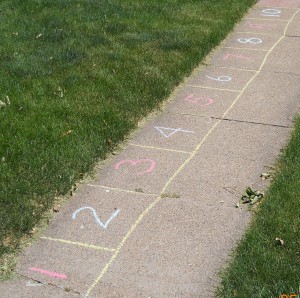
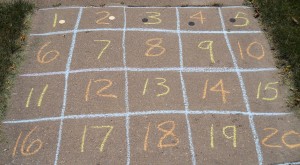
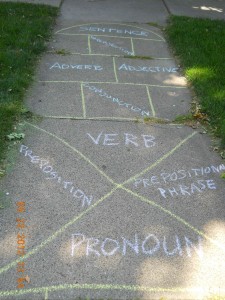
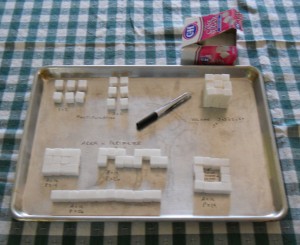
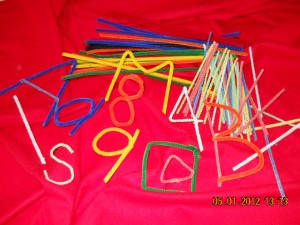
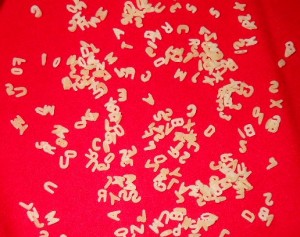
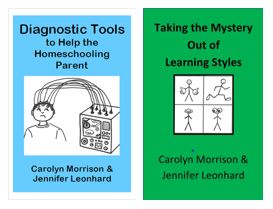
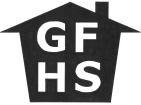
 Guilt-Free Homeschooling is the creation of Carolyn Morrison and her daughter, Jennifer Leonhard. After serious disappointments with public school, Carolyn spent the next 11 years homeschooling her two children, from elementary to high school graduation and college admission. Refusing to force new homeschooling families to re-invent the wheel, Carolyn and Jennifer now share their encouragement, support, tips, and tricks, filling their blog with "all the answers we were looking for as a new-to-homeschooling family" and making this website a valuable resource for parents, not just a daily journal. Guilt-Free Homeschooling -- Equipping Parents for Homeschooling Success!
Guilt-Free Homeschooling is the creation of Carolyn Morrison and her daughter, Jennifer Leonhard. After serious disappointments with public school, Carolyn spent the next 11 years homeschooling her two children, from elementary to high school graduation and college admission. Refusing to force new homeschooling families to re-invent the wheel, Carolyn and Jennifer now share their encouragement, support, tips, and tricks, filling their blog with "all the answers we were looking for as a new-to-homeschooling family" and making this website a valuable resource for parents, not just a daily journal. Guilt-Free Homeschooling -- Equipping Parents for Homeschooling Success!

Recent Comments